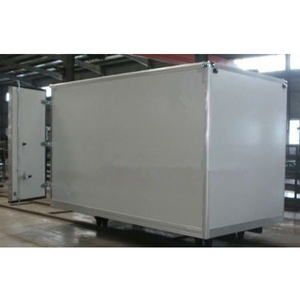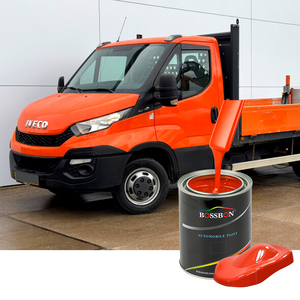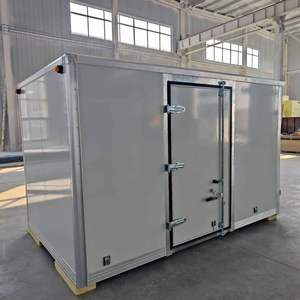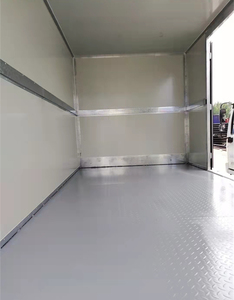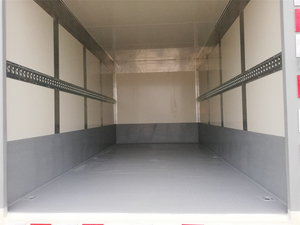Types of Composite Truck Bodies
The composite truck body consists of hybrid materials that bring together the best attributes of each component to create a robust and long-lasting solution for businesses. Each material provides certain advantages that suit various applications.
Fiberglass reinforced plywood is a common material in truck bodies. It combines the structural integrity of plywood with the durability of fiberglass, creating a:
- Lightweight yet strong solution ideal for hauling heavy cargo
- Material with excellent resistance to rot and corrosion
- Cost-effective option with long service life
Carbon fiber reinforced polymers are the modern materials of choice for luxury and electric trucks. These premium composites offer:
- Exceptional strength-to-weight ratio for maximum payload capacity
- Superior corrosion resistance in harsh environments
- Improved fuel efficiency due to weight reduction
- Sleek, modern aesthetic preferred by high-end commercial fleets
Glass fiber reinforced polymers provide an affordable alternative to carbon fiber. These versatile materials deliver:
- Good strength and durability for general trucking applications
- Excellent performance in environments with extreme loading or corrosion
- Lower cost than CFRP while maintaining many benefits
- Wide availability and manufacturing options
Polymer composites are primarily used to enhance the properties of other materials. These innovative combinations provide:
- Custom material properties for specific applications
- Lightweight and durable solutions (e.g., polyethylene and polypropylene blends)
- Flexibility in design and manufacturing processes
- Potential for recycled material content reducing environmental impact
Industry Insight: The global market for composite truck bodies is growing at over 5% annually, with CFRP seeing the fastest adoption rate in premium commercial vehicles. Fleet operators report up to 30% reduction in maintenance costs when switching from traditional metal bodies to composite alternatives.
Specifications of Composite Truck Bodies
Composite truck bodies combine various materials to create strong, durable, and lightweight solutions ideal for heavy-duty transportation. Understanding the key specifications helps businesses make informed decisions for their fleet needs.
| Specification | Description | Benefit |
|---|---|---|
| Material Composition | Combination of fiberglass, carbon fiber, and aramid fiber | Enhanced durability and strength |
| Weight | Up to 30% lighter than traditional steel bodies | Greater payload capacity and improved fuel efficiency |
| Corrosion Resistance | Naturally resistant to rust and chemical degradation | Longer service life with reduced maintenance requirements |
| Thermal Insulation | Superior insulation properties compared to metal | Better temperature regulation for sensitive cargo |
| Customization | Highly adaptable design options | Can be tailored to specific business needs and applications |
| Durability | Withstands extreme conditions including harsh weather | Suitable for diverse applications from logistics to agriculture |
| Environmental Resistance | Protection against UV radiation, chemicals, and moisture | Reduced wear and tear enhancing the truck's longevity |
- Heavier construction
- Susceptible to rust and corrosion
- Requires regular protective maintenance
- Less fuel efficient due to weight
- Lower initial cost
- Lightweight construction
- Naturally corrosion resistant
- Minimal maintenance requirements
- Better fuel economy
- Higher initial investment with long-term savings
Maintenance of Composite Truck Bodies
One of the major advantages of composite truck bodies is their simplified maintenance requirements compared to traditional materials. Following these essential maintenance practices will maximize the lifespan and performance of your investment:
Proper cleaning prevents material degradation and maintains appearance:
- Wash with mild cleansers and water, especially after carrying corrosive materials
- Avoid high-pressure washing directly on seams and joints
- Use non-abrasive cleaning tools to prevent surface scratching
- Schedule quarterly deep cleaning to remove embedded dirt and contaminants
Proactive inspection prevents costly repairs and downtime:
- Check for surface damage, cracks, or delamination monthly
- Inspect reinforcements and metal framework for integrity
- Examine mounting points and hardware for signs of stress
- Verify seals and weather stripping remain intact
Proper lubrication ensures smooth operation of all components:
- Apply marine-grade lubricants to hinges, latches, and moving parts
- Maintain door mechanisms with silicone-based lubricants
- Schedule lubrication every 3 months or more frequently in harsh conditions
- Use corrosion-inhibiting compounds on metal hardware
Surface protection extends longevity and maintains appearance:
- Apply UV-resistant sealants annually to prevent fiber degradation
- Use protective waxes designed for composite materials
- Reapply protective coatings after deep cleaning
- Consider professional coating services for heavy-use vehicles
Maintenance Tip: Create a digital maintenance log for your composite truck body. Track cleaning dates, inspections, and any repairs performed. This documentation not only ensures consistent maintenance but also provides valuable information for warranty claims and increases resale value.
How to Choose Composite Truck Bodies
Selecting the right composite truck body requires careful consideration of operational needs, material properties, and long-term value. Follow this comprehensive selection guide to make an informed decision:
The weight of your truck body directly impacts operational efficiency:
- Lightweight bodies are ideal for long-haul trucking and shipping companies that charge by weight
- Calculate your typical payload requirements to determine optimal body weight
- Consider fuel efficiency impacts – lighter bodies can provide 5-10% fuel savings
- Evaluate weight distribution effects on handling and stability
Match material durability to your specific application:
- Fiberglass-reinforced polymer for chemical transport or corrosive environments
- Carbon fiber-reinforced polymers for maximum strength in high-value cargo applications
- Consider impact resistance needs based on loading methods and cargo types
- Evaluate environmental exposure factors (coastal areas, extreme temperatures, etc.)
Ensure your specific operational needs can be accommodated:
- Evaluate manufacturer flexibility in design modifications
- Consider interior configuration options for specialized cargo
- Assess availability of accessories like tie-downs, racks, and storage systems
- Determine if future retrofitting or modifications will be possible
Consider total cost of ownership, not just purchase price:
- Calculate ROI based on expected service life (typically 10-15 years for quality composites)
- Factor in projected maintenance savings compared to traditional materials
- Consider resale value – composite bodies typically retain value better
- Evaluate manufacturer warranty terms and coverage duration
Selection Tip: When evaluating manufacturers, request references from current customers with similar applications to your own. Ask specific questions about performance in conditions that match your operational environment. Consider visiting facilities that use the composite bodies you're considering to see real-world performance.
How to DIY and Replace Composite Truck Bodies
While professional installation is recommended for most composite truck bodies, experienced operators with proper tools and facilities can perform a DIY replacement. Follow these steps carefully to ensure a safe and effective installation:
Select the Right Composite Truck Body
Before beginning any work, verify you have the correct replacement body:
- Confirm exact measurements match your truck chassis specifications
- Verify mounting points align with your specific truck model
- Ensure the replacement body meets or exceeds your load rating requirements
- Check that all necessary hardware and mounting brackets are included
Prepare Tools and Work Area
Proper preparation ensures a smooth installation process:
- Gather necessary tools: socket set, torque wrench, drill, sealant gun, etc.
- Secure a clean, level work area with adequate lighting
- Ensure sufficient overhead clearance for body removal and installation
- Have a second person available to assist with heavy lifting
Remove the Old Truck Body
Careful removal prevents damage to the chassis and components:
- Disconnect all electrical connections and document their locations
- Remove any accessories or equipment attached to the current body
- Unbolt the body from all mounting points on the chassis
- Carefully lift and remove the old body using appropriate lifting equipment
Prepare the Truck Chassis
Proper chassis preparation ensures optimal installation:
- Thoroughly clean the chassis mounting points of dirt, rust, and old sealant
- Inspect the chassis for any damage that needs repair before installation
- Verify mounting hardware is in good condition and replace if necessary
- Apply anti-corrosion treatment to metal surfaces if needed
Install the New Composite Body
Careful alignment and secure mounting are critical:
- Carefully position the new composite body over the chassis
- Align all mounting points precisely before lowering fully
- Apply appropriate sealant at mounting points to prevent water ingress
- Install and tighten mounting bolts according to manufacturer specifications
Complete Final Connections and Testing
Proper finishing ensures safety and functionality:
- Reconnect all electrical systems and test for proper function
- Check for any gaps between body and chassis; seal appropriately
- Reinstall any accessories or equipment that was removed
- Perform a complete inspection before returning the truck to service
Installation Warning: Composite bodies require different handling techniques than metal bodies. Never drill or cut without referencing manufacturer guidelines, as improper modifications can compromise structural integrity. Always use manufacturer-specified hardware and sealants to maintain warranty coverage.
Frequently Asked Questions
A composite truck body is a vehicle body made from a combination of materials such as fiberglass, carbon fiber, or other reinforced polymers. These bodies offer enhanced durability, lightweight characteristics (typically 20-30% lighter than steel), and superior resistance to corrosion and weather elements compared to traditional metal bodies. Their construction allows for customization while maintaining structural integrity for various commercial applications.
Composite truck bodies offer numerous benefits over traditional materials:
- Corrosion Resistance: Naturally immune to rust and chemical degradation
- Weight Reduction: 20-30% lighter than steel, increasing payload capacity and fuel efficiency
- Durability: Excellent impact resistance and ability to "bounce back" from minor collisions
- Thermal Insulation: Better temperature regulation for climate-sensitive cargo
- Reduced Maintenance: Lower lifetime maintenance costs without the need for rust prevention
- Extended Lifespan: Typically outlast metal bodies by 3-5 years in comparable conditions
- Noise Reduction: Natural sound dampening properties for quieter operation
Yes, composite materials can be used in various truck applications from light to heavy-duty transportation. They're particularly well-suited for:
- Delivery and freight transportation where weight savings increase payload capacity
- Food and refrigerated goods delivery due to their excellent insulation properties
- Chemical transportation because of their corrosion resistance
- Service trucks operating in harsh environments or coastal regions
- Long-haul operations where fuel efficiency is paramount
While appropriate for most applications, extremely high-temperature environments or specialized heavy equipment may have specific requirements that should be discussed with manufacturers.
The initial investment for composite truck bodies is typically 15-25% higher than traditional steel or aluminum alternatives. However, this upfront cost difference is often offset by:
- Lower maintenance costs (up to 30% reduction over the life of the vehicle)
- Improved fuel efficiency due to weight reduction (5-10% depending on application)
- Extended service life (typically 10-15 years versus 7-10 for steel bodies)
- Higher resale value with better condition retention
- Reduced downtime for repairs and maintenance
When considering total cost of ownership over the vehicle's lifetime, composite bodies often provide a better return on investment, particularly for fleets with high utilization rates.
Composite truck bodies require significantly less maintenance than traditional metal bodies:
- Regular Cleaning: Periodic washing with mild cleansers is sufficient, with special attention after exposure to corrosive materials
- Inspection: Quarterly visual inspections for any damage, particularly around mounting points and high-stress areas
- Surface Protection: Annual application of UV-protective sealants helps maintain appearance and structural integrity
- Hardware Maintenance: Standard lubrication of moving parts like hinges and latches is the main ongoing maintenance requirement
- Damage Repair: Minor damage can often be repaired with composite-specific patch kits rather than complete panel replacement
Unlike steel bodies, composite bodies don't require rust prevention treatments, regular repainting, or corrosion remediation, which significantly reduces lifetime maintenance costs and effort.



